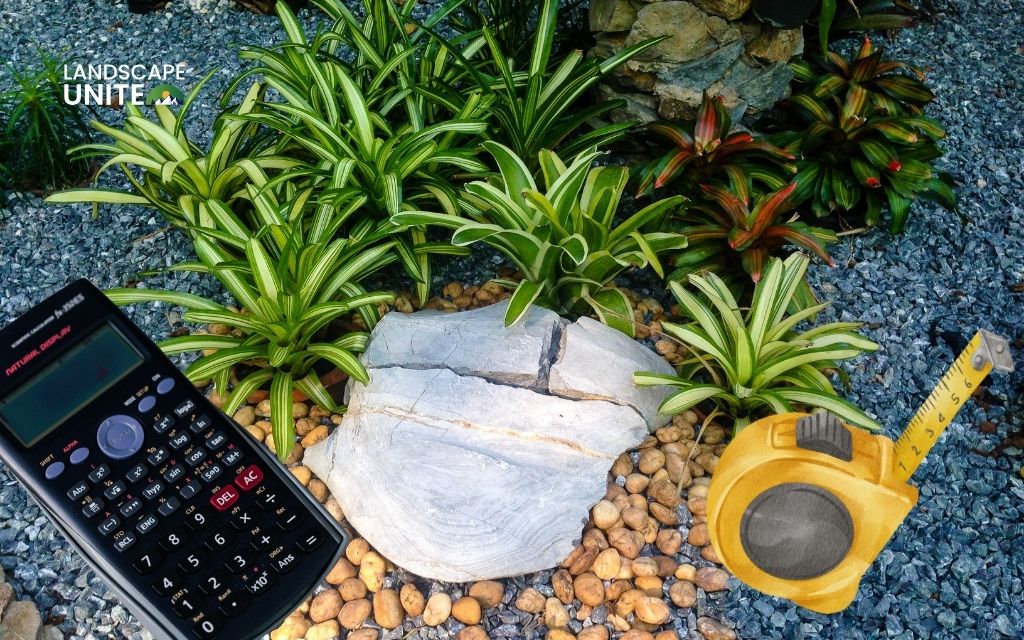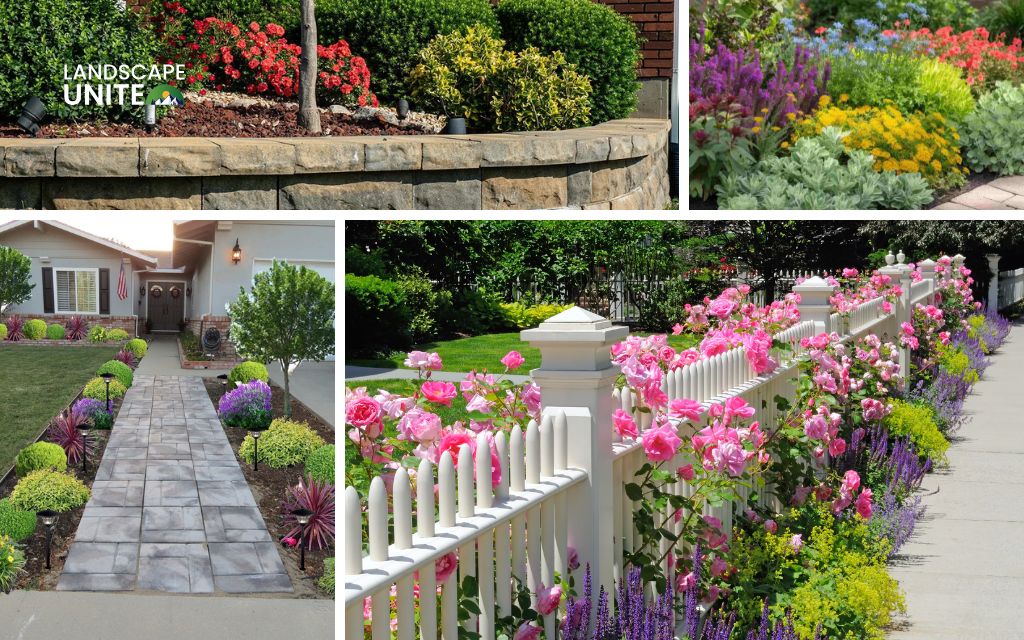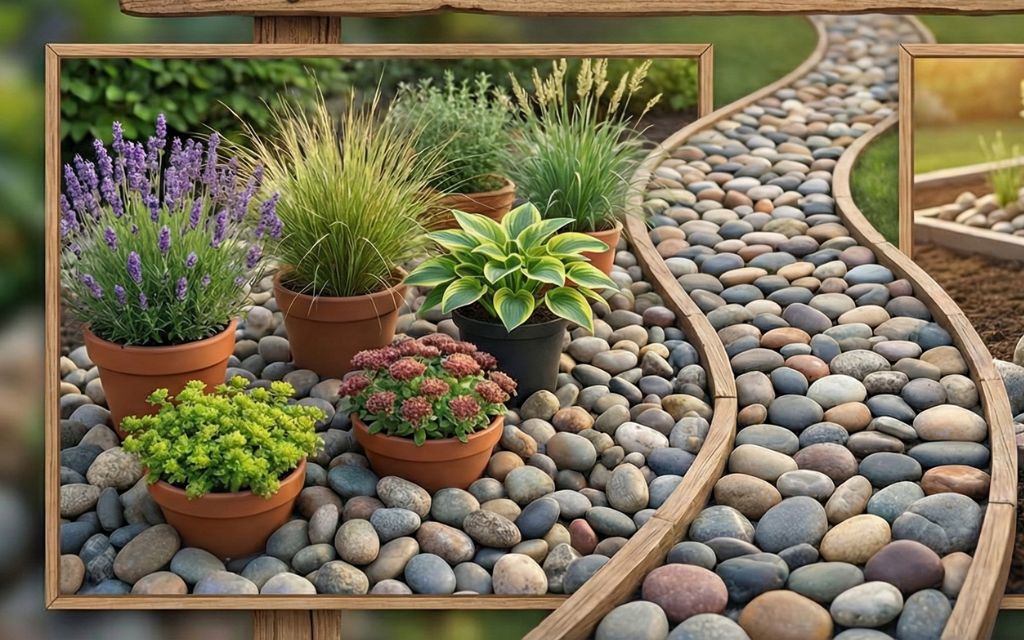Tired of flat, one-dimensional flower beds? The secret to a designer-level garden is incorporating ornamental grasses. These versatile plants are the backbone of modern landscape design, offering stunning texture, graceful movement, and captivating color from spring through winter. Unlike many perennials, they are famously low-maintenance, drought-tolerant, and resistant to most pests and diseases, making them a smart and beautiful choice for any gardener.
Whether you have a sun-drenched border, a shady corner, or a simple container garden, there is a perfect grass waiting to transform your space. This guide will walk you through everything you need to know about choosing the right grasses for flower beds, from selecting varieties to planting and care. Get ready to elevate your garden with the dynamic beauty of ornamental grasses.
Top 10 ornamental grasses for stunning flower beds
1. Feather Reed Grass (Calamagrostis ‘Karl Foerster’)

This tall, upright grass is known for its early plumes and strong vertical presence. Growing 4-5 feet tall, Feather Reed Grass produces striking wheat-colored flower plumes in early summer, well ahead of most ornamental grasses. Its strictly upright form makes it perfect for creating vertical accents without requiring staking.
- Growing conditions: Full sun, hardy in zones 4-9, tolerates clay soil and occasional flooding
- Best uses: Tall borders, mass plantings, contemporary designs
- Why it’s beloved: Reliable, non-invasive, and one of the first grasses to bloom
This cool-season grass maintains its architectural form through winter, making it invaluable for year-round structure. Its clumping habit means it won’t spread aggressively through your flower bed.
2. Blue Fescue (Festuca glauca ‘Elijah Blue’)
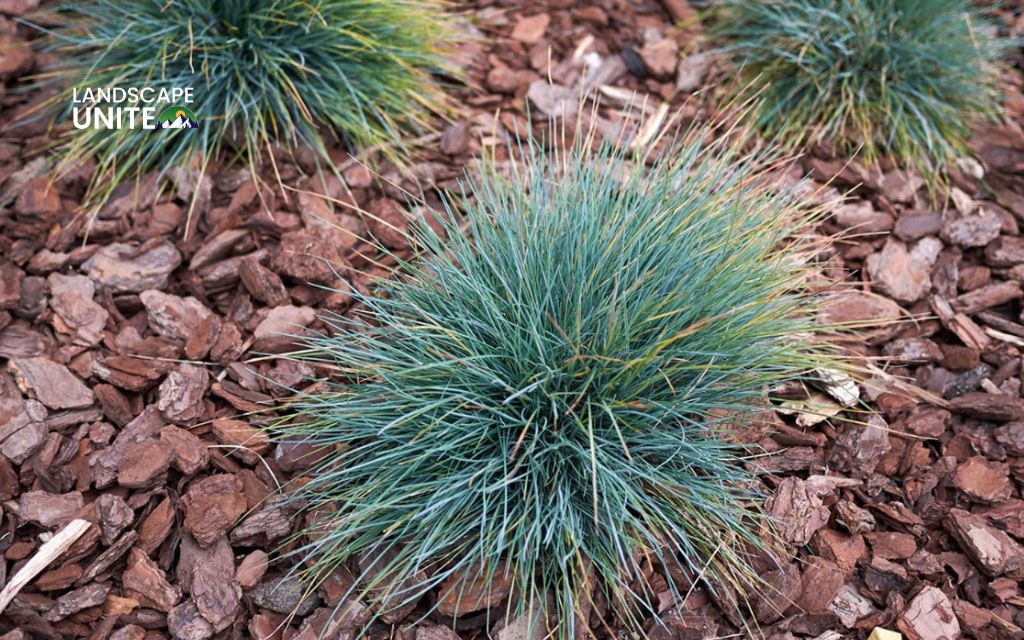
This small, clumping blue-hued grass is perfect for borders and edgings. Growing only 8-12 inches tall, Blue Fescue forms dense, spiky mounds of stunning silvery-blue foliage. Its compact size and striking color make it ideal for low growing grasses for flower bed borders.
- Growing conditions: Full sun, hardy in zones 4-8, prefers well-drained soil
- Best uses: Front of borders, rock gardens, container combinations
- Why it’s beloved: Intense blue color provides contrast with green foliage
This evergreen grass provides color and texture even in winter. Plant several together for maximum impact, spacing them 12 inches apart to create a flowing ribbon of blue along your flower bed edge.
3. Fountain Grass (Pennisetum setaceum ‘Rubrum’)
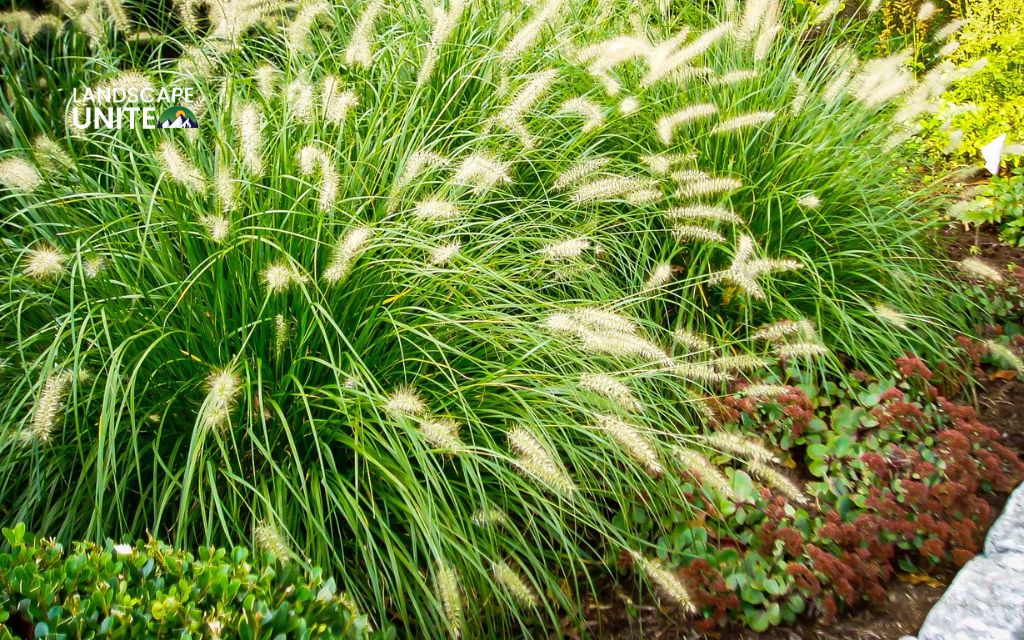
Loved for its arching form and fuzzy, bottlebrush-like plumes, this decorative grass for flower beds creates romantic, flowing effects. Its burgundy foliage and pinkish plumes arch gracefully outward, creating a fountain-like mound 3-4 feet tall and wide.
- Growing conditions: Full sun, hardy in zones 9-11 (grown as annual elsewhere), drought-tolerant once established
- Best uses: Focal points, container “thrillers,” mass plantings
- Why it’s beloved: Dramatic color and movement, blooms from mid-summer until frost
While technically tender, purple Fountain Grass is worth growing as an annual for its incredible impact. The plumes catch light beautifully, creating a glowing effect in late afternoon sun.
4. Little Bluestem (Schizachyrium scoparium)
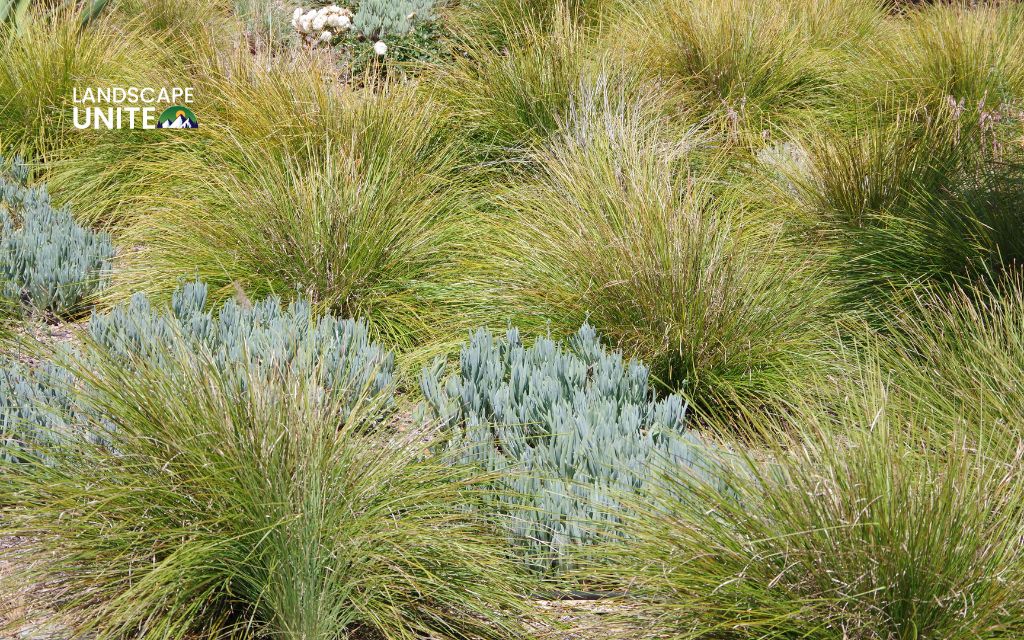
This native prairie grass offers spectacular color shifts from blue-green in summer to fiery red-bronze in fall, providing multi-season appeal. Growing 2-4 feet tall, Little Bluestem undergoes a dramatic seasonal transformation that few plants can match. By autumn, entire clumps blaze with copper, orange, and deep red tones that persist through winter.
- Growing conditions: Full sun, hardy in zones 3-9, extremely drought-tolerant
- Best uses: Native gardens, naturalized areas, mixed borders
- Why it’s beloved: Stunning fall color, supports wildlife, thrives in poor soil
This warm-season grass is virtually indestructible once established. Its wispy seed heads create a beautiful “haze” effect when backlit by low sun, and birds adore the seeds throughout winter.
Want to create a native plant garden? Explore more native landscaping ideas on our blog.
5. Switchgrass (Panicum virgatum)

This tough native prairie grass offers many cultivars with blue or red foliage options. Growing 3-6 feet tall depending on cultivar, Switchgrass provides airy, cloud-like flower panicles in late summer that age to golden tan. Varieties range from ‘Heavy Metal’ with blue foliage to ‘Shenandoah’ with burgundy-red tips.
- Growing conditions: Full sun to part shade, hardy in zones 5-9, adaptable to various soil types
- Best uses: Mixed borders, rain gardens, naturalized meadows
- Why it’s beloved: Exceptional drought tolerance, beautiful fall color, ecological value
This warm-season grass serves multiple design roles simultaneously. A single clump can act as a vertical accent, textural element, or when planted in groups, create an effective privacy screen.
6. Japanese Forest Grass (Hakonechloa macra)
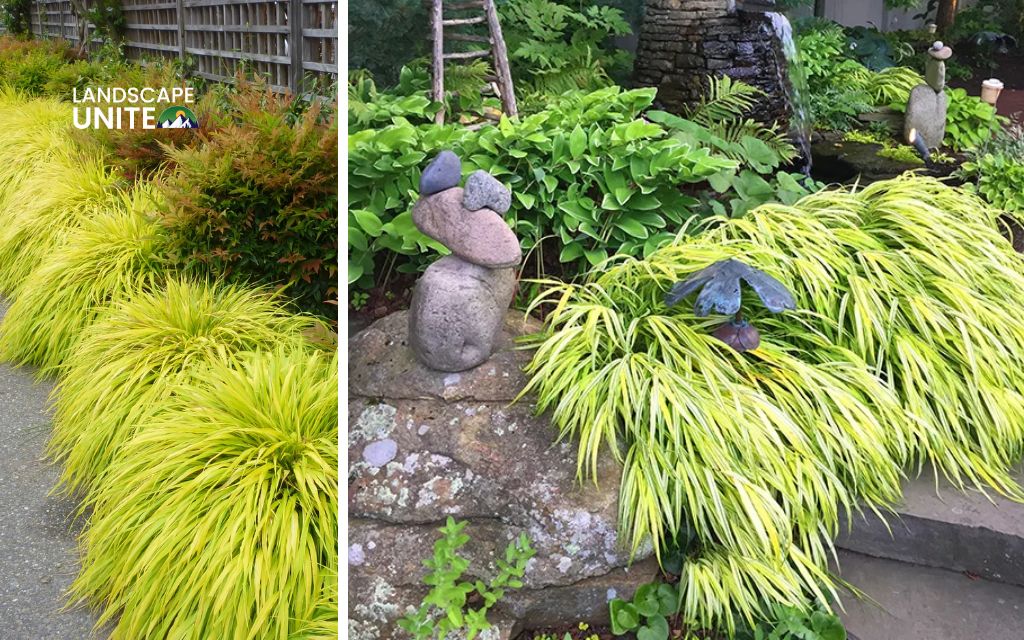
One of the few grasses that thrives in shade, its cascading, bamboo-like leaves brighten dark corners. Growing 12-18 inches tall, this slow-growing gem forms graceful, arching mounds that resemble miniature bamboo. Variegated cultivars like ‘Aureola’ feature golden-yellow leaves with green striping.
- Growing conditions: Part to full shade, hardy in zones 5-9, prefers consistent moisture
- Best uses: Shade gardens, woodland edges, containers
- Why it’s beloved: Unmatched elegance in shade, beautiful fall color (peachy-pink)
This grass’s unique ability to illuminate shady spots makes it invaluable for problem areas. Its refined texture and movement bring unexpected grace to shade gardens where few other grasses succeed.
7. Big Bluestem (Andropogon gerardii)
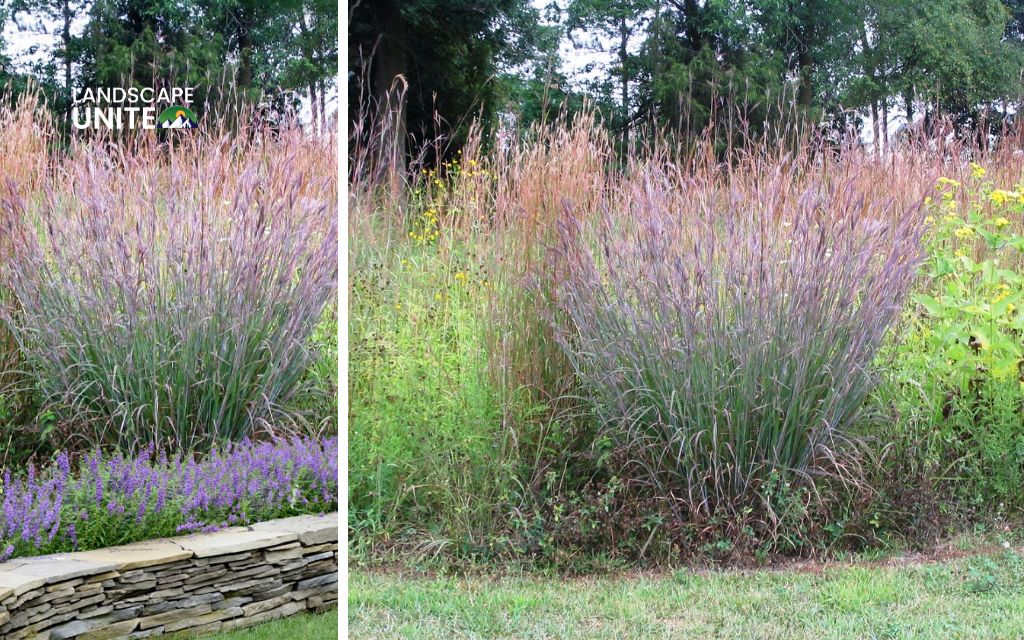
Its three-branched seed heads give it the unique nickname “Turkey Foot Grass.” Growing 4-8 feet tall, Big Bluestem is a true prairie giant. In late summer, distinctive seed heads appear with three finger-like projections that do indeed resemble turkey feet. Fall brings spectacular color, with foliage turning burgundy, orange, and copper.
- Growing conditions: Full sun, hardy in zones 4-9, very drought-tolerant
- Best uses: Back of borders, prairie restorations, wildlife gardens
- Why it’s beloved: Dramatic height, interesting seed heads, incredible fall color
This warm-season native is called “the king of the prairie” for good reason. Its deep root system (up to 8 feet) makes it virtually drought-proof and excellent for erosion control. The seed heads provide crucial winter food for birds.
8. Purple Love Grass (Eragrostis spectabilis)
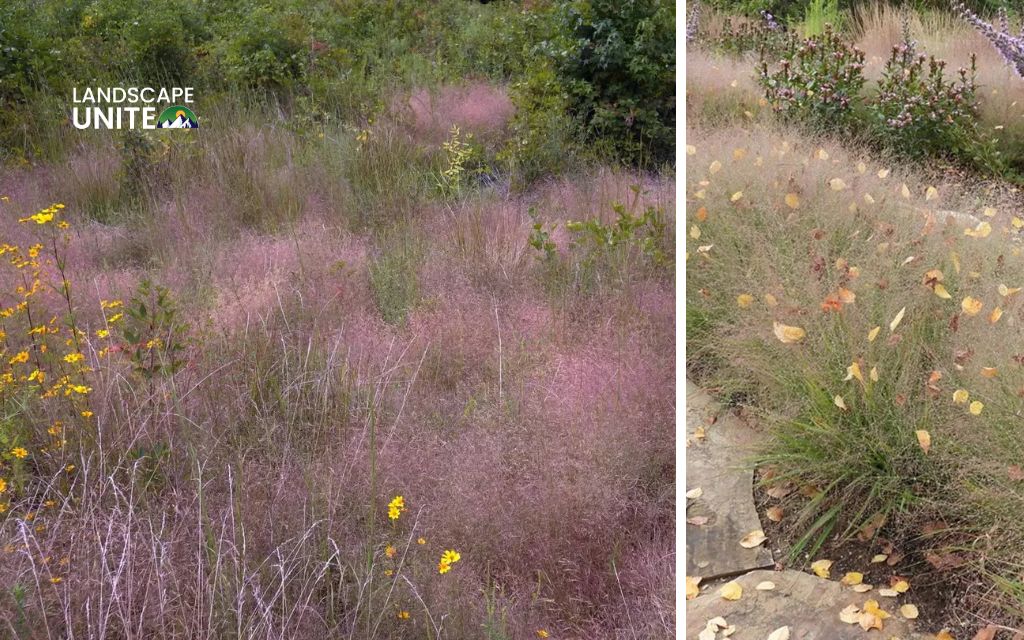
This grass creates a delicate, hazy cloud of pinkish-purple flowers in late summer, appearing almost like a mist over the garden bed. Growing 12-18 inches tall, Purple Love Grass produces incredibly fine, airy flower panicles that create a see-through “cloud” effect few other plants can replicate.
- Growing conditions: Full sun to part shade, hardy in zones 5-9, tolerates poor soil
- Best uses: Front to middle borders, naturalized areas, softening hardscapes
- Why it’s beloved: Ethereal appearance, long bloom period, unique texture
This native warm-season grass looks best when planted in groups where its cloud-like effect can be fully appreciated. The flowers emerge green, turn reddish-purple, then fade to straw-colored seed heads that persist through winter.
9. Blue Oat Grass (Helictotrichon sempervirens)
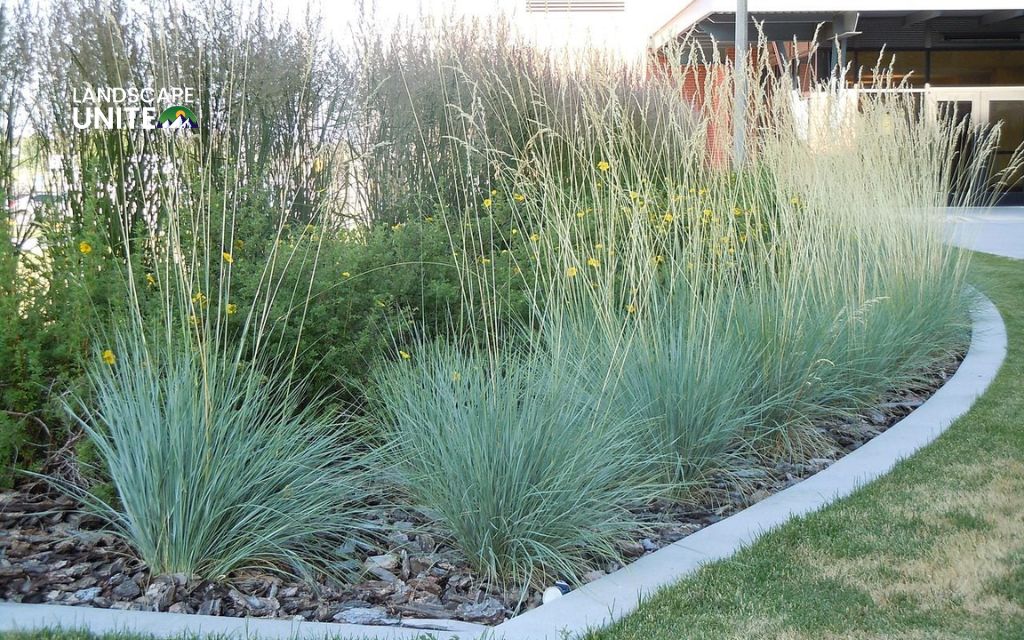
This striking, spiky blue grass forms a dense, fountain-like mound. Growing 2-3 feet tall, Blue Oat Grass creates perfectly rounded clumps of intense blue foliage. In early summer, wheat-like flower stalks rise above the foliage, adding another 12 inches of height.
- Growing conditions: Full sun, hardy in zones 4-8, requires excellent drainage
- Best uses: Rock gardens, Mediterranean-style designs, containers
- Why it’s beloved: Intense blue color, evergreen in mild climates, neat habit
This cool-season grass provides immediate impact with its steel-blue color. Unlike Blue Fescue, it maintains a larger presence in the landscape. Good drainage is essential, as soggy soil can cause crown rot.
10. Maiden Grass (Miscanthus sinensis)
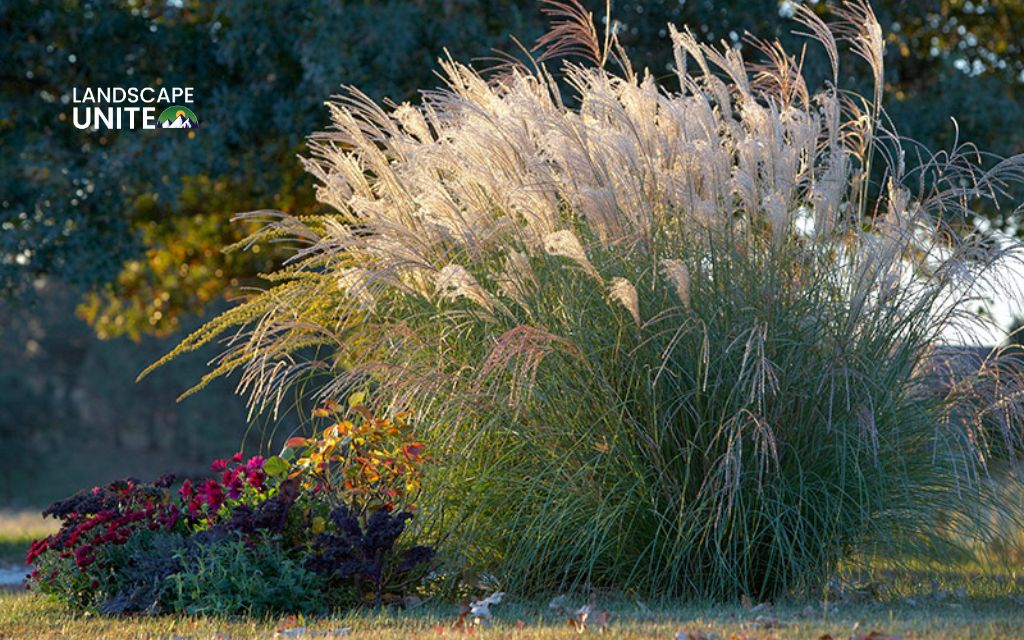
This large, graceful grass features showy plumes that persist into winter. Growing 4-8 feet tall depending on cultivar, Maiden Grass is the quintessential specimen grass. Its elegant, arching leaves and spectacular fall plumes create dramatic focal points. Varieties include ‘Morning Light’ with variegated foliage and ‘Zebrinus’ with horizontal yellow banding.
- Growing conditions: Full sun, hardy in zones 5-9, adaptable to various soils
- Best uses: Specimen plantings, tall borders, privacy screens
- Why it’s beloved: Impressive size, showy plumes, excellent winter interest
This warm-season grass provides structure and movement on a grand scale. The plumes emerge copper-pink in fall, then age to silvery-white, catching light beautifully through winter. Plant in spring for best establishment.
Planting and caring for your ornamental grasses
Step-by-step planting guide for a healthy start
Proper planting ensures your grasses for flower beds establish quickly and thrive for years. Follow these steps for success:
Timing: Plant container-grown ornamental grasses in spring or early fall. Spring planting allows warm-season grasses a full growing season to establish before winter. Cool-season grasses can handle fall planting better.
Site preparation: Clear the planting area of weeds and amend heavy clay soils with compost to improve drainage. Most grasses prefer well-drained soil and will struggle in constantly wet conditions.
Planting process:
- Dig a hole twice as wide as the root ball but no deeper
- Remove the grass from its container and gently loosen circling roots
- Place the plant in the hole at the same depth it was growing in the container
- Backfill with native soil, firming gently to eliminate air pockets
- Water thoroughly to settle the soil
- Apply 2-3 inches of mulch around (not touching) the base
Spacing: Follow the mature width recommendations for each variety. Grasses look best when they have room to display their natural form without crowding neighbors.
Watering needs: establishing your new plants
Newly planted ornamental grasses need consistent moisture during their first growing season to develop strong root systems. Water deeply once or twice weekly, depending on rainfall and temperature. The goal is to keep the root zone evenly moist but not waterlogged.
After establishment (usually one full growing season), most grass plants for flower beds become remarkably drought-tolerant. Mature plants typically survive on natural rainfall alone, though occasional deep watering during extreme drought produces better appearance.
Morning watering is ideal as it allows foliage to dry before evening, reducing disease risk. Deep, infrequent watering encourages deep root growth, making plants more resilient during dry periods.
The right way to cut back grasses (and when to do it)
Knowing when and how to cut back your decorative grass for flower beds is essential for their health and appearance. The timing depends on the grass type and your aesthetic preferences.
When to cut back:
- Warm-season grasses: Cut back in late winter or early spring before new growth emerges. This allows you to enjoy their winter interest while removing old foliage before it interferes with new growth.
- Cool-season grasses: Cut back in early spring before growth resumes. Some gardeners prefer to tidy them in late fall.
How to cut back:
- Gather the foliage into a bundle using rope or bungee cords
- Cut the entire clump to 4-6 inches above ground using sharp pruners, hedge shears, or a power trimmer for large grasses
- Remove and compost the old foliage (or leave it for birds to use as nesting material)
- Rake away any debris from the crown
Never cut back ornamental grasses in fall unless they’re diseased. The foliage provides winter interest and protects the crown from temperature fluctuations.
Dividing and transplanting overgrown clumps
Most ornamental grasses benefit from division every 3-5 years. Signs that division is needed include dead centers, reduced vigor, or flopping growth. Division rejuvenates plants and provides new specimens for other areas.
Best timing: Divide warm-season grasses in spring as new growth emerges. Divide cool-season grasses in early fall.
Division process:
- Water the plant thoroughly the day before dividing
- Cut back the foliage to 6-8 inches to make handling easier
- Dig around the entire clump, then lift it from the ground
- Use a sharp spade, saw, or axe to split large clumps into sections (each should have healthy roots and several growth points)
- Replant divisions immediately at the same depth they were growing
- Water thoroughly and keep consistently moist until established
Large, established grasses can be surprisingly difficult to divide. Don’t hesitate to use aggressive tools like saws or reciprocating saws for tough root systems.
Need professional help with landscape installation? Contact Mile High Lifescape for expert assistance tailored to your specific needs and budget.
FAQs about grasses for flower beds
Will ornamental grasses take over my flower bed?
Most ornamental grasses are clump-forming and will not spread aggressively. Varieties like Feather Reed Grass, Blue Fescue, and Fountain Grass stay where you plant them, slowly increasing in size each year but remaining in a defined clump. However, some grasses like certain Miscanthus varieties can self-seed. Choose sterile cultivars or deadhead before seeds mature if spreading is a concern. Native grasses typically have deep root systems that grow downward rather than spreading horizontally. For specific recommendations about non-invasive varieties for your area, explore more on our blog.
Can I grow ornamental grasses in pots or containers?
Absolutely! Ornamental grasses excel in container gardening. Their versatility allows them to serve as thriller, filler, or spiller elements in mixed containers. Compact varieties like Blue Fescue and Japanese Forest Grass work beautifully in smaller pots, while medium-sized grasses like Fountain Grass create dramatic focal points in large containers. Use quality potting mix with good drainage, water more frequently than in-ground plants, and protect containers from extreme winter temperatures in cold climates by moving them to sheltered locations or wrapping them for insulation.
Do I need to fertilize my ornamental grasses?
One of the low-maintenance benefits of grasses for flower beds is their minimal fertilizer requirements. In fact, most ornamental grasses prefer lean soil and can become floppy with too much fertilizer, especially nitrogen. For established plants in average garden soil, fertilizing is typically unnecessary. If your soil is particularly poor or plants show weak growth, apply a balanced, slow-release fertilizer in spring at half the recommended rate. Native grasses especially thrive without any supplemental feeding.
What are some good companion plants for ornamental grasses?
Ornamental grasses pair beautifully with many perennials and shrubs. Their fine texture contrasts wonderfully with bold, broad-leaved plants. Excellent companions include:
Coneflowers (Echinacea) for prairie-style combinations
Black-eyed Susans (Rudbeckia) for sunny borders
Sedums for late-season interest
Russian Sage for airy, purple blooms
Daylilies for contrasting form
Asters for fall color
The key is creating texture contrast. Pair grasses with plants that have different leaf shapes, flower forms, and bloom times to create dynamic, layered designs. Discover more perennial border ide
Are ornamental grasses deer-resistant?
Yes, most grass plants for flower beds are naturally deer-resistant. Deer typically avoid grasses because they prefer tender, broad-leaved plants. Varieties like Feather Reed Grass, Blue Fescue, Switchgrass, and Little Bluestem are rarely browsed even in areas with high deer pressure. This deer resistance, combined with their low maintenance requirements, makes ornamental grasses excellent choices for properties where deer are problematic. While no plant is completely deer-proof when deer are starving, ornamental grasses are among the most reliable options for creating beautiful, undamaged landscapes in deer country.
Conclusion
Your journey to a more dynamic and beautiful garden starts with incorporating the right grasses for flower beds. These remarkable plants deliver unmatched texture, graceful movement, and stunning four-season interest with minimal effort. From the vertical elegance of Feather Reed Grass to the shade-loving beauty of Japanese Forest Grass, there’s a perfect variety waiting to transform your landscape.
Start planning which of these stunning ornamental grasses you’ll add to your flower beds this season. Whether you’re creating a native meadow, designing a contemporary border, or simply adding texture to your front yard, these versatile plants will elevate your garden to a professional level.
Landscape Unite is your trusted resource for expert gardening and landscape design tips. Our blog delivers practical advice, inspiring ideas, and detailed guides to help your outdoor spaces thrive. Contact Landscape Unite today for more great tips and discover new posts on our blog that will transform your garden into the beautiful, low-maintenance oasis you’ve always wanted.
